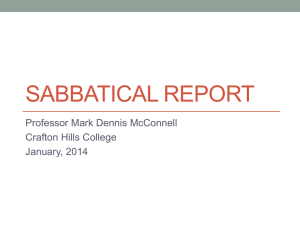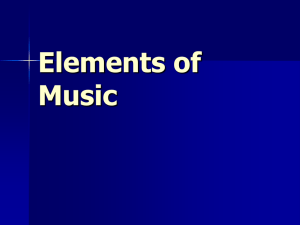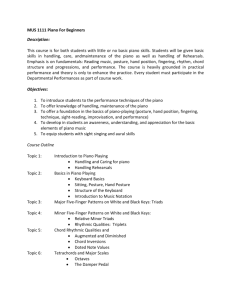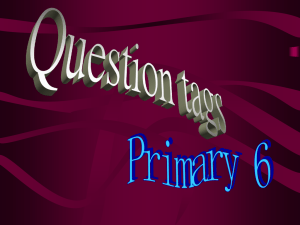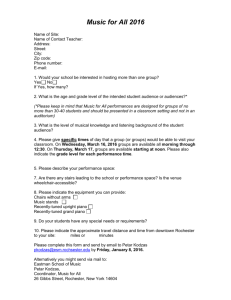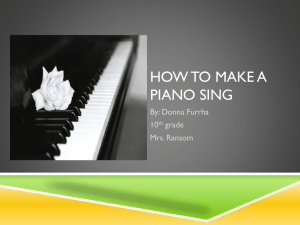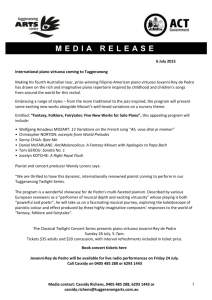District Overview The goal of the Brandywine Heights Area School
advertisement
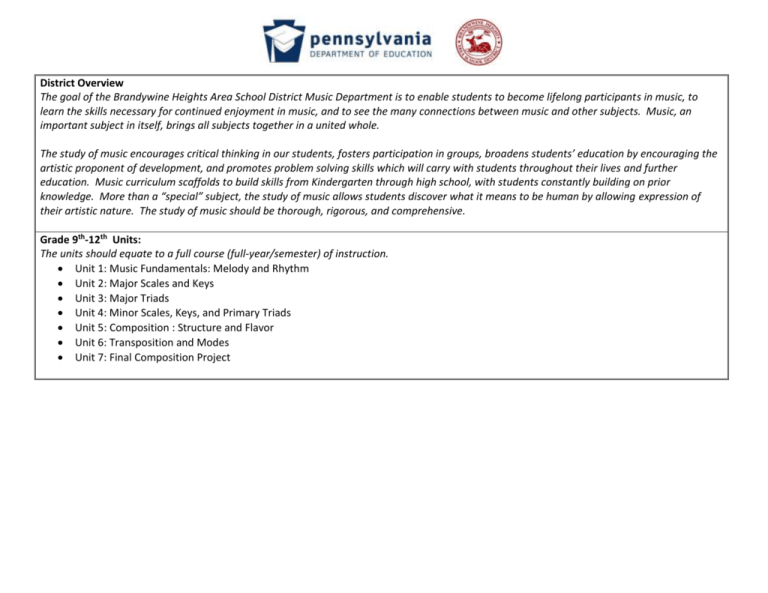
District Overview The goal of the Brandywine Heights Area School District Music Department is to enable students to become lifelong participants in music, to learn the skills necessary for continued enjoyment in music, and to see the many connections between music and other subjects. Music, an important subject in itself, brings all subjects together in a united whole. The study of music encourages critical thinking in our students, fosters participation in groups, broadens students’ education by encouraging the artistic proponent of development, and promotes problem solving skills which will carry with students throughout their lives and further education. Music curriculum scaffolds to build skills from Kindergarten through high school, with students constantly building on prior knowledge. More than a “special” subject, the study of music allows students discover what it means to be human by allowing expression of their artistic nature. The study of music should be thorough, rigorous, and comprehensive. Grade 9th-12th Units: The units should equate to a full course (full-year/semester) of instruction. Unit 1: Music Fundamentals: Melody and Rhythm Unit 2: Major Scales and Keys Unit 3: Major Triads Unit 4: Minor Scales, Keys, and Primary Triads Unit 5: Composition : Structure and Flavor Unit 6: Transposition and Modes Unit 7: Final Composition Project Subject: Music Theory Grade: 9-12 Unit Title: Music Fundamentals: Melody and Rhythm Unit Overview/Essential Understanding: How is sound organized to make music? How does the structure of a musical piece create its order and clarity? How is melody created? Unit Objectives: Notate the elements of music using F, G and moveable C, clefs, including noteheads, stems, flags, beams, and rests, using correct vertical alignment and stem direction, barlines, brackets, braces, repeat signs, endings, and accidentals. Notate and recognize simple rhythmic patterns (beats and subdivisions), notate and recognize simple, compound, and complex meters, and organize rhythms into appropriate groupings (beaming and barring). Focus Standards Addressed in this Unit: National Standards for Music Education: 1,2,5,6,7,8,9 Concepts/Content: Students will… Competencies/Skills: Students will be able to… (identify) Identify parts of a note Identify and write rhythmic symbols Interpret relationships among rhythmic symbols Identify and interpret rhythmic concepts in written music Interpret time signature Apply time signature and counts to rhythmic patterns Create rhythmic patterns using time signature and rhythmic symbols Hear rhythmic patterns and transfer to written format Rhythm Parts of a note- stem, flag, beam Rhythmic symbols- whole note, half note, quarter note, rests Rhythmic relationships Rhythmic terms: beat, measure, bar line, double bar line Time signature- top number, bottom number Counting rhythms Composition of original rhythmic patterns Rhythmic dictation: hear rhythmic pattern and transfer to written form Description of Activities: Basic music dictation Looking at piano music and identifying notes in both clefs Use mnemonic devices to tell what interval two notes are Musical Alphabet List the letters in the musical alphabet Visually and aurally identify an octave Visually and aurally identify conjunct motion Hear conjunct patterns of pitches and transfer to written form Pitch on the Staff Visually identify and draw the treble clef and bass clef Discuss the purpose of the treble and bass clef Construct pitches in treble and bass clef on the staff Identify pitches in treble and bass clef on the staff Define ledger lines Identify and construct pitches on the staff using ledger lines Piano Identify names of white keys on the piano Play simple melodies on the piano using white keys Composition: Create original melodies using white keys on the piano Define half step and whole step and identify on the piano Define accidentals, including sharp, flat, double sharp, double flat, natural Identify names of black keys on the piano using accidentals Define enharmonic Melody Pitch Musical alphabet Octave Conjunct motion Pitch on the Staff Treble clef pitches Bass clef pitches Stem direction Ledger lines Grand staff Octave registers Piano White keys on the piano Half steps, whole steps Accidentals- sharp, flat, double sharp, double flat, natural Enharmonic Identify enharmonic pitches on the piano Identify and construct pitches on the staff using accidentals Play black and white key melodies on the piano with proper rhythm, tempo, hand/finger position Composition: Create original pitch and rhythmic patterns using conjunct motion Dictation: Hear patterns of conjunct pitch and rhythmic symbols and transfer to written forms Assessments: In class assignments Weekly quizzes Unit exam Additional Resources: Robert Ottman: Music for Sight Singing Robert Ottman: Rudiments Piano book Subject: Music Theory Unit Title: Major Scales and Keys Grade: 9-12 Unit Overview/Essential Understanding: How does the Circle of Fifths help to establish key signatures? Unit Objectives: Demonstrate the ability to write major and minor key signatures on the staff (circle of fifths). Demonstrate the ability to notate simple rhythmic patterns from dictated examples and identify simple rhythmic motives and meters from aural examples. Focus Standards Addressed in this Unit: National Standards for Music Education: 1,2,5,6,7,8,9 Concepts/Content: Students will… Major Scales Define scale, major scale, chromatic scale Construct major scales on the staff in treble and bass clef Play major scales on the piano Competencies/Skills: Students will be able to… (identify) Major Scales Scale Chromatic scale Major scale construction-location of half steps and whole steps Key Signatures Define the purpose and identify the location of a key List the order of sharps and flats in a key signature Write key signatures on the staff Given the key signature, identify the key name Use the Circle of Fifths/Fourths to identify the key name Compose an original melody that demonstrates understanding of: Key Signatures Purpose and location of key signatures Order of sharps and flats in key signature Writing key signatures on the staff in treble and bass clef Identifying key name Circle of fifths Description of Activities: Theory textbook and workbook Music dictation Piano workbook -rhythmic symbols and relationships -time signature -key signature Play melodies on the piano in treble and bass clef, demonstrating appropriate pitch, rhythm, tempo, fingers, hand position Assessments: In class assignments Weekly quizzes Unit exam Additional Resources: Robert Ottman: Music for Sight Singing Robert Ottman: Rudiments Finale-Music Notation software DVD Player Subject: Music Theory Unit Title: Major Triads Grade: 9-12 Unit Overview/Essential Understanding: Why is it necessary to be able to sing intervals and melodies? Why is it important to be able to transcribe single note melodies by keyboard dictation? Unit Objectives: All simple intervals and their inversion, and compound intervals to the interval of a 15th The student will be able to relate this knowledge to the keyboard. Focus Standards Addressed in this Unit: National Standards for Music Education: 1,2,5,6,7,8,9 Concepts/Content: Students will… Define chord, triad Identify the parts of a triad Construct major, minor, diminished, and augmented triads on the staff Identify triads visually and aurally Play major triads on the piano List the scale degree names for pitch in a scale Identify the three primary triads according to scale Discuss the use of harmonic minor scale in music composition. Identify the Roman numerals representing both major and minor primary triads Harmonize a melody in minor key, using primary triads Assessments: Competencies/Skills: Students will be able to… (identify) Chord Triad Parts of a triad- root, third, fifth Kinds of triads- major, minor, diminished, augmented Three primary triads Scale degree names Description of Activities: Theory textbook and workbook Music dictation Piano workbook In class assignments Weekly quizzes Unit exam Additional Resources: Robert Ottman: Music for Sight Singing Robert Ottman: Rudiments Finale-Music Notation software DVD Player Subject: Music Theory Grade: 9-12 Unit Title: Minor Scales, Keys, and Primary Triads Unit Overview/Essential Understanding: Why is it important to play or sing scales? How is music built upon patterns found in major and minor scales? How did prolific composers in history adjust the use of scale structure to develop new genres and styles of music? Unit Objectives: All major, minor, diminished, and augmented triads (In open and closed position, In root position, first inversion and second inversion) The student will use figured bass symbols, and provide roman numeral analysis of chords within a given tonality Focus Standards Addressed in this Unit: National Standards for Music Education: 1,2,5,6,7,8,9 Concepts/Content: Competencies/Skills: Description of Activities: Students will… Construct the natural minor scale on the staff Play the natural minor scale on the piano Discuss the role of relative scales with relation to major scales Discuss the relationship between relative scales and major/minor key signatures Given the major key name, identify the relative minor key name Given the minor key name, identify the relative major key name Identify and construct major and relative minor key signatures Construct the harmonic minor scale on the staff Students will be able to…(identify) Natural minor scales Relative scales Key signatures in minor Harmonic minor scale Melodic minor scale Primary triads for minor keys Ternary form Rondo form Jump Bass accompaniment Theory textbook and workbook Music dictation Piano workbook Compare and contrast the harmonic minor scale in relation to the relative minor scale Play harmonic minor scales on the piano Discuss the relationship between the harmonic minor scale and minor key signatures Composition Compose two original melodies, one base on the natural minor scale and one based on the harmonic minor scale Construct the melodic minor scale on the staff Compare and contrast all three forms of the minor scale- natural, harmonic, and melodic Construct minor triads on the staff Identify Roman numerals for the three primary triads in minor Construct the three primary triads on the staff in minor keys Define ternary form and rondo form Analyze ternary form and rondo form in written music Define jump bass accompaniment in written music Analyze jump bass accompaniment in written music Create an original composition that demonstrates the following concepts: -minor keys -ternary or rondo form -jump bass accompaniment -repetition and variation Assessments: In class assignments Weekly quizzes Unit exam Additional Resources: Robert Ottman: Music for Sight Singing Robert Ottman: Rudiments Finale-Music Notation software DVD Player Subject: Music Theory Grade: 9-12 Unit Title: Composition - Structure and Flavor Unit Overview/Essential Understanding: Is there good harmony and bad harmony? What does harmony add to music? Can you have rhythm without beat? Why does each voice and instrument have its own timbre? Unit Objectives: To exercise creative imagination for sound. To learn and utilize new compositional techniques. To develop compositional skills through regular and focused practice. To expand awareness of the richness and diversity of contemporary music. To foster an environment for creative exchange and constructive criticism. To move toward the acquisition of a personal musical language. To develop skills in effective notation. To develop skills working with specific instruments and voices. To prepare scores and parts for performance. To produce a substantial portfolio of compositions. Focus Standards Addressed in this Unit: National Standards for Music Education: 1,2,5,6,7,8,9 Concepts/Content: Competencies/Skills: Description of Activities: Students will… Students will be able to…(identify) Review: Proper interaction between melody and harmony Conjunt and disjunct melodies Phrases and periods Candences Writing effective melodies: phrase, period, climax note, conjunct/disjunct tension and release Theory textbook and workbook Music dictation Piano workbook Finale Noteflight Chord progressions and role of primary triads Define cadence in terms of: Purpose Location in relation to phrase and period Define half cadence and identify location and role in relation to phrases/periods Define authentic cadence and identify role and location in relation to phrases/periods Analyze written music and identify half and authentic cadences Discuss the role of the following concepts in music composition: Tension and release Climax note Repetition and variation Create an original composition that demonstrates: Interpretive markings Primary triads Musical rules Define the following terms: Accompaniments Glissando accompaniment triad accompaniment in a melody Arpeggiation Create original compositions that demonstrate triad accompaniment, glissando, accompaniments, and arpeggiation Define the following terms with relation to form: Form Accompaniments- piano accompaniment, glissando, arpeggiation Binary form Noteflight Tutorial Location Note input Editing a score Email a file Save as MIDI and open in Finale Expression markings and articulations Key signature and time signature Theme Binary form- definition, letters, length, characteristics Compare and contrast simple binary form and rounded binary form Create an original composition in simple binary form and convent to rounded binary form Demonstrate the ability to locate Noteflight on the internet and login Create a new score, assign it as “private” and input pitches and rhythms to create a short melody. Use the editor to change individual notes, edit a full measure, select measures, staves, notes, chords, or multiple measures, move or copy measures, and add new measures. Demonstrate methods for exporting and emailing music files including saving as a MIDI file and opening in Finale Add expression markings and articulations to melodies Assessments: In class assignments Weekly quizzes Unit exam Additional Resources: Robert Ottman: Music for Sight Singing Robert Ottman: Rudiments Finale-Music Notation software DVD Player Subject: Music Theory Unit Title: Transposition and Modes Grade: 9-12 Unit Overview/Essential Understanding: What is transposition? Transposition is used when attempting to write music for various instruments not in concert key, i.e. clarinet, trumpet, saxophone, French horn, etc. What is orchestration? Orchestration is used when arranging a piece of music for various instruments i.e. taking a choral work and writing it for band. Unit Objectives: Play selected compositions, scales and chord progressions, sight-read pieces, begin transposition and harmonization. Focus Standards Addressed in this Unit: National Standards for Music Education: 1,2,5,6,7,8,9 Concepts/Content: Competencies/Skills: Description of Activities: Students will… Students will be able to…(identify) Define orchestration and arrangements Define terms relating to instruments including: instrumentation, range, register, technical ability, mood, transposition, balance Identify the instrumental families and the common instruments including: Strings, woodwinds, brass, pitched and non-pitched percussion, keyboards Define transposition and discuss the purpose of transposition in composition Define the term “interval” Construct major, minor, and diminished intervals on the staff. Discuss the relationship between intervals and transposition Orchestration, arrangement, range, register, technical ability, mood, balance, transposition Instrumental families: strings, woodwinds, brass, pitched and nonpitched percussion, keyboards Terms relating to transposition: Intervals, concert pitch, concert instruments, transposing instruments, transposing key signatures Concepts relating to modes: Modes, type of modes, key signature and mode Theory textbook and workbook Music dictation Piano workbook Finale Noteflight Define the following terms with relation to transposition: Concert pitch, concert instruments, transposing instruments Identify the transposition characteristics of the most common instruments in the band and orchestra Demonstrate how to transpose key signature for different instruments in the band and orchestra Composition: Given a vocal score, transpose for four different instruments Define a mode Construct the following modes on the staff: Ionian, Dorian, Phrygian, Lydian, Mixolydian, Aeolian, Locrian Given the key signature, identify the mode Composition: Create original music that demonstrate the following concepts: Range, register, technique, mood, transposition, balance, modes Assessments: In class assignments Weekly quizzes Unit exam Additional Resources: Robert Ottman: Music for Sight Singing Robert Ottman: Rudiments Finale-Music Notation software DVD Player Subject: Music Theory Unit Title: Composition Project Grade: 9-12 Unit Overview/Essential Understanding: How do composers translate external influential elements into music? Unit Objectives: Students will experience the development of skills needed to analyze and evaluate music. Students will continue to explore music’s relationship with other disciplines and its impact on culture, and development of ability to perform/record/present/discuss original compositions. Focus Standards Addressed in this Unit: National Standards for Music Education: 1,2,5,6,7,8,9 Concepts/Content: Competencies/Skills: Description of Activities: Students will… Students will be able to…(identify) Create an original composition that demonstrates student achievement in: Major/minor keys Key signatures Modes Chords and chord progressions Transposition Orchestration Form Major/minor keys Key signatures Modes Chords and chord progressions Transposition Orchestration Form Theory textbook and workbook Music dictation Piano workbook Finale Noteflight Assessments: In class assignments Weekly quizzes Unit exam Additional Resources: Robert Ottman: Music for Sight Singing Robert Ottman: Rudiments Finale-Music Notation software DVD Player

